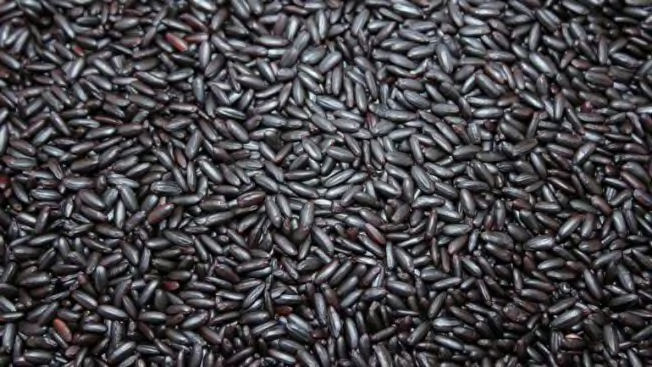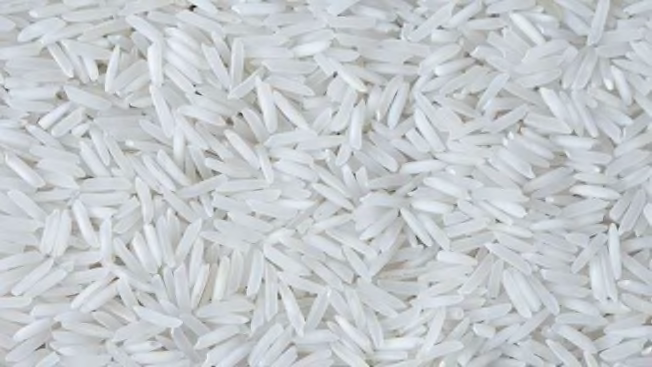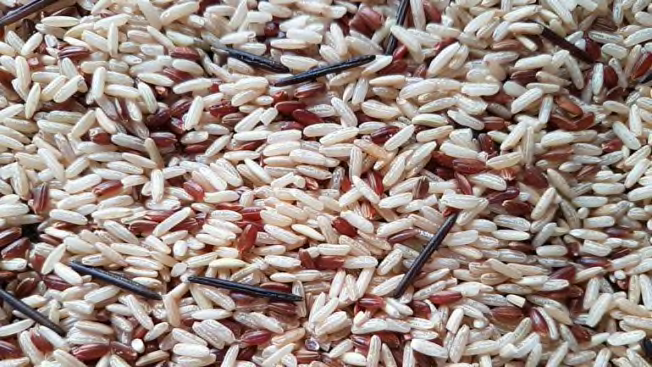12 Types of Rice You Should Try—and the Best Ways to Use Them
These varieties are anything but run of the mill

Chef JJ Johnson owns Fieldtrip, a rice-focused eatery in Harlem, New York, and is obsessed with heirloom and heritage rice varieties. But he wasn’t always a fan of rice.
“My first memories of rice are of my grandma walking around the kitchen drinking asopao out of her coffee cup,” Johnson says. “I loved that Puerto Rican soupy rice.” But when his grandmother passed away, Johnson says his working mother started cooking parboiled rice from a box because it took only 10 minutes. “Those were probably my worst memories of rice.”
Types of Rice
There are two major rice classifications: indica (long-grain) and japonica (medium-to-short grain). Both contain two types of starch—amylose (dry starch) and amylopectin (sticky starch)—but the proportions of each are what differentiate long-grain and short-grain rice.
| Long-Grain Rice | Medium-to-Short-Grain Rice |
| ∙ Has more amylose (dry starch). | ∙ Has more amylopectin (sticky starch). |
| ∙ Elongates as it cooks into firm, separate grains. | ∙ Grains grow rounder as they cook and cling together. |
| ∙ Fluffy texture. | ∙ Soft, tacky texture. |
| ∙ Typically grown in hot tropical and semitropical conditions. | ∙ Typically grown in cooler climates and in mountainous regions. |
Arborio
A short- to medium-grain Italian rice used to make risotto. The grains are translucent with a white center that stays al dente when cooked while the outside softens, absorbs flavorful liquids, and releases starch to give risotto its creamy consistency. Risotto grains have little amylose, the dry starch that makes rice hold its form, which allows it to achieve this texture.
Best uses: risotto and soupy rice dishes such as asopao and risi e bisi.
Basmati
A long-grain rice that is highly regarded for its fragrance and dramatic elongation when cooked. True basmati is grown—and considered a minor god—in India and Pakistan. Many hybrids are grown elsewhere, including the U.S., but they don’t grow long like basmati.
Best uses: in Indian, Pakistani, Nepalese, and Mediterranean dishes; in dishes where you don’t want the grains to stick together, such as biryani, sabzi polo, and arroz con pollo; any recipe that calls for long-grain rice.
Black Rice
Comes in medium- and short-grain varieties and is also known as black sticky rice or the less sticky forbidden rice. Grown mostly in Southeast Asia, these kernels are surrounded by flavorful and nutrient-rich black bran that turns the rice purple when cooked.
Best use: sweetened with coconut milk and sugar for sweet sticky rice.

Photo: Serenethos/Getty Images Photo: Serenethos/Getty Images
Bomba
A short- to medium-grain Spanish rice also called Valencia rice. It’s prized for its tender bite and ability to absorb a large amount of liquid—and flavor—without losing its shape or going mushy.
Best use: paella.
Brown Rice
Not actually a rice type, because all rice is brown before it’s milled. Brown rice still has its outer bran layer, which has nutrition, fiber, and a nutty flavor. You can find brown versions of all rice varieties. This layer of bran acts as a shield to cooking liquid, which means you need more water and more cooking time to get it tender.
Best uses: as a heartier, more nutritious substitute for any white rice variety.

Photo: Pakin Songmor/Getty Images Photo: Pakin Songmor/Getty Images
Carolina Gold
Golden-yellow long-grain rice cultivated by African slaves in South Carolina during colonial times (not to be confused with the Carolina brand rice). In the 1700s this rice was a valuable export commodity that made plantation owners very wealthy, but it barely survived the Civil War. Carolina Gold became near extinct but has found a recent revival thanks to the Gullah Geechee people, descendants of the original West Africans, who helped preserve this grain. Today it’s produced by Anson Mills. What makes this rice unique is its japonica makeup and indica appearance. When cooked, it has notes of roasted nuts and fresh bread.
Best uses: as an accompaniment to low-country dishes and for porridge, pilau, purloo, jollof rice, and red rice.
Glutinous Rice
Sticky rice (also called sweet rice) with 100 percent amylopectin. This variety can be white or black and is a specialty of Thailand, Japan, China, and other Asian countries.
Best uses: as an accompaniment to Southeast Asian salads (like laab and papaya salad) and grilled meats, and sweetened with coconut milk and sugar for sweet sticky rice.
Jasmine
Florally fragrant medium- to long-grain rice that cooks into a moist, tender grain. This is the mother rice (and major export) in Thailand and a variety that doesn’t fit neatly into either the indica or japonica classifications. It’s a longer grain but has more amylopectin (sticky starch) than amylose (dry starch).
Best uses: as an accompaniment to stir-fries and curries, and for fried rice, gallo pinot, rice soup, and congee.

Photo: Alexandra Krol/Getty Images Photo: Alexandra Krol/Getty Images
Parboiled
Rice that has been pressure-steamed before milling to reduce breakage and force nutrients from the bran into the endosperm. This light tan rice is trademarked as converted rice by Uncle Ben’s. Parboiled rice isn’t to be confused with instant rice; it must be fully cooked and results in a dry and firm rice.
Best uses: dishes that require separate, firm grains with minimal stickiness, or when you want a nutritious grain that isn’t as fibrous and chewy as brown rice.
Red Rice
Short-grain rice with a deep-red bran layer that cooks into a chewier, earthier brown rice. The most common is the Camargue red rice of southern France, but you can also find Thai red rice (also known as riceberry) and Bhutanese red rice more easily stateside these days. Bhutanese red rice is actually a medium-grain that turns pink when cooked.
Best uses: in salads, gumbo, and mixed with white rice varieties for flavor and texture.

Photo: Victor Cardoner/Getty Images Photo: Victor Cardoner/Getty Images
Sushi Rice
A short-grain rice that’s smooth and glassy, also often referred to as Japanese rice. When cooked, it’s on the sticky side but still has a toothsome bite to it. It can be enjoyed plain or seasoned with rice vinegar, sugar, and salt for sushi rice.
Best uses: sushi, on its own sprinkled with furikake, and for bibimbap and rice pudding.
Wild Rice
Looks like rice and grows like rice but is technically a grass. This slender, dark, and chewy cousin to rice is the only grain indigenous to North America and is an important staple for some Native Americans. Today it’s an expensive delicacy because it’s grown in small quantities, mostly in Minnesota, California, and central Canada.
Best uses: stuffing, salads, and soup.

Photo: Barbara Reichardt/Getty Images Photo: Barbara Reichardt/Getty Images
Buying Rice
Where your rice comes from matters, not only in terms of quality but also for health. CR’s investigation of arsenic levels in rice found that type and origin play a major role in the amount of arsenic in rice. Arsenic is a metal found in soil and groundwater all over the world. When ingested over a long period of time, it has been linked to an increased risk of cancer and metabolic problems in adults and neurological problems in children.
“Since rice is grown in flooded fields, it absorbs a lot of arsenic,” says Tunde Akinleye, the lead tester in CR’s investigation of arsenic levels in rice. “Rice from the U.S. South tends to be high in arsenic because insecticides were widely used on the plantations, and that stuff stays in the soil for a long time.”
Akinleye says basmati rice from California, India, and Pakistan have much lower levels. Japanese rice is also generally low in arsenic, and any type of white rice has about half the levels found in brown rice because arsenic settles mostly in the bran (the brown part of rice).
Washing rice helps reduce exposure, but also consider reducing your intake. If you choose better rice, you can safely eat up to 3 cups per week. If you love your Carolina Gold or Texmati, that’s fine; just limit your servings to 1½ cups per week.
Storing Rice
The best temperature to store rice is 40° F or cooler, but white rice can be stored at room temperature (around 70° F) if you put oxygen-absorbing packets into the container and use the rice within two years. If you don’t eat rice often, keep it tightly covered in the refrigerator or freezer. Brown, red, and black rice should always be refrigerated because bran is perishable and can turn rancid quickly.




















